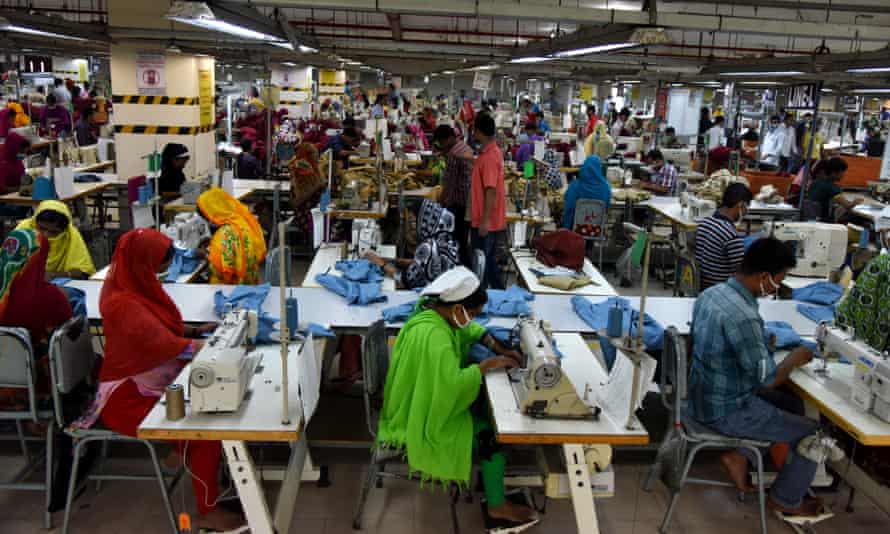Fast Fashion Is Bad for the Environment
The way industry needs to fundamentally change in order to mitigate the environmental impact of fast way, experts have said.
Clothes rental, better recycling processes, pollution control technology and the innovative employ of offcuts are among measures that could aid, they said.
The researchers produced a written report – pubished in the journal Nature Reviews Earth & Surround – into the environmental cost of the industry, and how it needs to alter to deal with some of the many associated issues.
While the figures are debated, the Intergovernmental Panel on Climate Change (IPCC) has calculated the style manufacture produces 10% of global carbon dioxide emissions every year, while information technology is estimated to use around 1.5 trillion litres of water annually. Meanwhile concerns have been rising most pollution, from chemical waste to microplastics.
Among the developments accounted to be exacerbating the problems, is fast way – cheap apparel bought and cast aside in rapid succession as trends alter – such as the £1 bikini sold by Missguided last twelvemonth.

"It is really a global problem," said Dr Patsy Perry, a co-writer of the research from Manchester Academy.
Perry and an international group of colleagues point out that the global nature of the fashion industry means clothes may have travelled around the world several times during manufacture, while it is estimated that if 3% of garment transportation shifted from ship to air cargo – a burgeoning trend in the industry – it could result in over 100% more than carbon emissions than if all garment transportation was by ship.
The squad also points to the manufacture's h2o consumption, carbon dioxide emissions, textile waste product, and use of chemicals – substances they say not only pose environmental risks, but health risks for those involved in the industry. "In one example, a single European fabric-finishing company uses over 466g of chemicals per kilogram of textile," they write.
And while many garments are designed in the US or EU, they are often produced in developing countries. The team says that not only increases fabric waste through poor communication of requirements, but regulations around pollution are oftentimes less strict in the countries of manufacture. "The waste water is going out into freshwater streams and polluting the rivers that people are fishing from [and] living from," said Perry.

The report stresses limited natural resources mean the manner industry must change, and sets out a number of ways it could become greener, including embracing renewable energy and developing new methods for recycling, besides as reducing the use of polyester – a not-biodegradable fibre, produced from petrochemicals, that dominates the way industry.
They besides debate the industry should focus on producing better quality, long-lived items, while innovations similar clothes rental and new approaches to resale should be scaled upward.
But they add together: "Consumers must understand style as more of a functional product rather than amusement, and be ready to pay higher prices that account for the ecology affect of fashion."
It is not the offset time solutions to fast fashion accept been mooted. Concluding year, MPs on the Environmental Inspect Committee (EAC) proposed a number of measures, including a 1p charge on each new detail of clothing to fund better recycling and collection. All were rejected by the government.

Libby Peake of the Dark-green Alliance said the United kingdom had a particular problem when it came to fast fashion.
"Nosotros buy more clothing per head than any other country in Europe, including nearly twice every bit much as Italians, who are ameliorate known for their fashion sense," she said.
As well equally emphasising the need for improved quality and clothing rental schemes, she said, the report highlighted the importance of buying wearable second paw. Industry-led initiatives to reduce environmental costs had been ineffective while consumption continued to ascension.
"Slow fashion is the just sustainable future for the manufacture and the planet," she said.
Conduct Somers, the co-founder of the entrada Fashion Revolution, also stressed the use of chemicals in the fashion industry, as flagged past the new report, is of particular business, especially in clothes made exterior the Eu where it is difficult to know what substances have been used.
Prof Steve Evans, an expert in industrial sustainability at Cambridge Academy, also welcomed the report. But he said it was unclear what proportion of the manufacture's environmental impact was downwards to fast fashion per se. A cardinal claiming for the "closed loop" industry was that dissimilar sectors, from product to retailing and recycling, must begin to work together.
Only Evans said a future where the charge per unit of fibre product and disposal was lowered need not hateful a dearth of new outfits, if garments were rented or re-sold. "It might exist fast fashion from the perspective of the fashionista," he said, "but it is slow from the perspective of the planet."
0 Response to "Fast Fashion Is Bad for the Environment"
Post a Comment